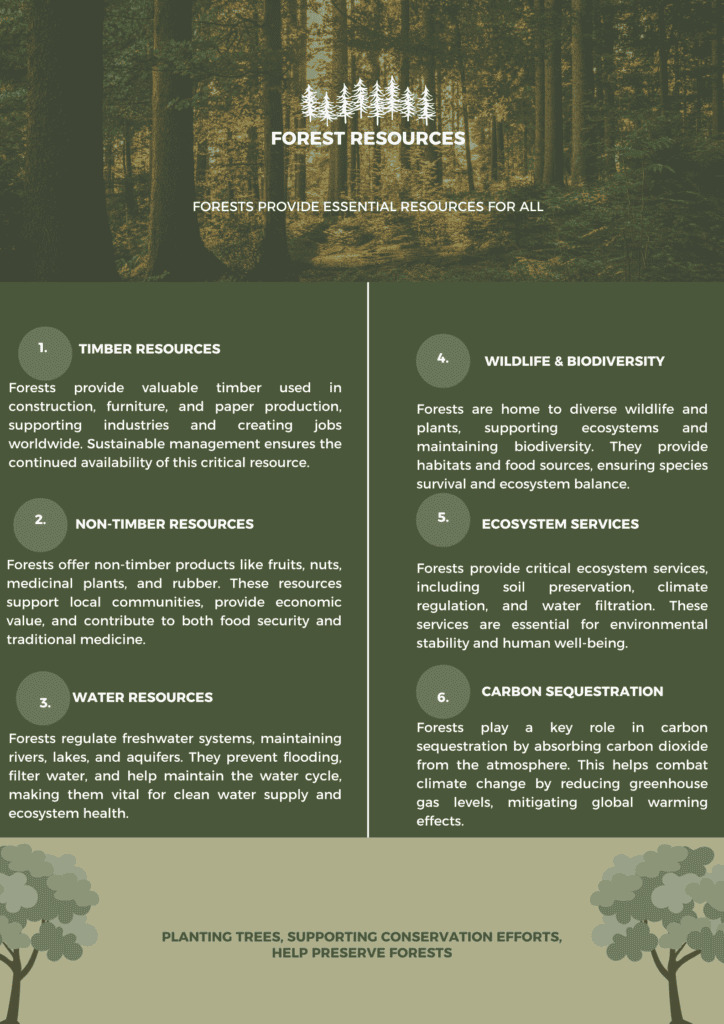Forests are vital to life on Earth, offering a variety of resources that support both nature and human needs. These resources include timber, water, and medicinal plants. By understanding the different types of forest resources, we can better appreciate how forests sustain our daily lives.
Moreover, learning about the types of forest resources helps us see their role in environmental sustainability. Forests not only provide materials but also play a crucial part in balancing the ecosystem.
Therefore, recognizing the value of these resources encourages us to protect forests. Through proper management, we can ensure that forests continue to provide benefits for generations to come.

Definition of Forest Resources
Forest resources are the materials and benefits we obtain from forests. These include both renewable resources and non-renewable resources. Renewable resources are those that can regenerate naturally, like timber, fruits, and medicinal plants.
These resources can replenish if managed properly, making them sustainable over time. On the other hand, non-renewable resources, such as minerals and fossil fuels, cannot be replaced once extracted.
Understanding the types of forest resources is crucial because it helps in managing these resources effectively. Forests also provide essential ecosystem services, like water regulation and carbon storage.
These services are vital for the environment and human life. By knowing the different resources forests offer, we can use them wisely and sustainably.
Significance of Forests
Forests are essential for ecological balance, economic growth, and social well-being. They provide us with resources like timber, food, and medicines. These materials are crucial for many industries and support livelihoods, especially in rural areas.
Furthermore, forests play a key role in biodiversity by offering habitats for countless species. Without forests, many plants and animals would struggle to survive.
In addition, forests are important in regulating the climate. They absorb carbon dioxide, helping reduce the impact of climate change. Forests also help control water cycles, preventing floods and preserving water quality.
Human communities benefit from forests as well, not only economically but socially, as forests provide jobs and recreation.
When we consider the different types of forest resources, we realize how vital forests are. From renewable resources to non-renewable materials, forests sustain our needs while protecting the environment. Therefore, it is crucial to manage these resources responsibly to maintain the ecological balance.
Classification of Forest Resources
Forest resources are broadly classified into three categories: renewable resources, non-renewable resources, and ecosystem services. Each type plays a different role in sustaining both nature and human life.
Renewable Resources
Renewable forest resources are those that can be replenished naturally over time. Examples include timber, fruits, bamboo, and medicinal plants. These resources can regenerate through sustainable practices like selective logging or replanting.
Renewable resources are vital for industries like construction and medicine. However, over-exploitation can harm forest ecosystems. Therefore, sustainable harvesting ensures that these resources remain available for future generations.
Non-Renewable Resources
Non-renewable forest resources, such as minerals, oil, and natural gas, do not regenerate once extracted. These resources are found beneath the forest floor and take millions of years to form. While they provide economic benefits, extracting them can cause long-term environmental damage.
Mining and drilling often lead to deforestation, habitat destruction, and soil erosion. Thus, careful management and minimizing extraction are key to protecting forest ecosystems.
Ecosystem Services
Forests provide ecosystem services that support both nature and humans. These include carbon sequestration, water regulation, and soil preservation. Forests absorb carbon dioxide, helping to combat climate change. They also regulate water flow, reducing the risk of floods and maintaining clean water supplies.
Additionally, forests prevent soil erosion by holding the soil together with their roots. These services are essential for maintaining environmental balance and supporting human activities.
Understanding the types of forest resources and their classification helps in creating policies for their sustainable use.
Also Read: Importance of Environmental Conservation
Different Types of Forest Resources
Forests offer a wide variety of resources that benefit humans and the environment. These different types of forest resources include both tangible products and crucial ecosystem services.
Understanding the resources provided by forests helps in appreciating their true value and ensuring their sustainable use. Below, we’ll explore key categories of forest resources.
Timber Resources
Timber is one of the most important resources derived from forests. Wood from trees is used for various purposes, including construction, furniture, and paper production. Hardwood and softwood timber are vital for the global construction industry, from framing houses to making flooring and beams.
In many countries, timber forms the backbone of the economy by creating jobs and supporting local industries.
Besides construction, timber is also used in making furniture and everyday items like doors and window frames. The value of timber goes beyond just the material—it provides livelihoods to millions of people involved in logging, transportation, and woodworking industries.
Managing timber harvesting sustainably ensures that forests can continue to provide this resource for generations.
Non-Timber Forest Products
While timber is essential, forests offer many other resources known as Non-Timber Forest Products (NTFPs). These include fruits, nuts, medicinal plants, and rubber. For example, forests provide foods like wild berries, mushrooms, and honey, which are vital to the diets of rural communities.
Many of these products also have commercial value, being sold in local and international markets.
Medicinal plants from forests are used in traditional healing and pharmaceutical industries. For instance, herbs like ginseng and neem are harvested for their health benefits.
The production of rubber from trees is another example of a valuable NTFP. These products contribute to the economy while also supporting local communities. Therefore, managing NTFPs sustainably is critical to ensuring both their long-term availability and the protection of forest ecosystems.
Water Resources
Forests play a key role in regulating water systems. They act as natural filters, maintaining watersheds and freshwater supplies. Many rivers, lakes, and aquifers are sustained by healthy forest ecosystems.
Trees and forest soils help capture rainfall, allowing water to infiltrate the ground and replenish underground aquifers. This water can then be used for drinking, agriculture, and industry.
Forests also prevent flooding by slowing down the flow of water during heavy rains. In mountainous areas, forests protect water bodies by reducing soil erosion, ensuring that rivers and lakes remain clear. Besides, the water cycle is supported by forests, which return moisture to the atmosphere through transpiration.
Protecting forest areas is crucial for maintaining the water resources that both people and ecosystems rely on.
Wildlife and Biodiversity
Forests are home to an incredible diversity of wildlife, playing a vital role in preserving habitats for countless species. From small insects to large mammals like tigers and elephants, forests provide the shelter and food that wildlife needs to survive.
Forests also support biodiversity by offering different environments, such as tropical rainforests, temperate forests, and mangroves, each housing unique species of plants and animals.
Biodiversity in forests is important for maintaining healthy ecosystems. It ensures that ecosystems can recover from disturbances and continue to provide essential services like pollination, seed dispersal, and pest control.
Conservation efforts that protect forest biodiversity are crucial, as the loss of any species can have a ripple effect on the entire ecosystem. Safeguarding wildlife habitats within forests ensures a balanced and healthy environment.
Ecosystem Services
Forests provide essential ecosystem services that benefit both the planet and humanity. One of the most important services is carbon sequestration. Forests absorb carbon dioxide, a greenhouse gas, helping to mitigate climate change. By storing carbon in trees and soils, forests act as a buffer against global warming.
Additionally, forests help in preserving soil by preventing erosion. Tree roots hold the soil in place, reducing the loss of fertile land.
Furthermore, forests play a key role in regulating local and global climates. They moderate temperatures, influence rainfall patterns, and create stable environments for other ecosystems to thrive.
These ecosystem services highlight the broader significance of forest resources, extending beyond just the materials we extract. Protecting forests and their services ensures a sustainable future for all living beings.
Challenges in Managing Forest Resources
Managing forest resources presents significant challenges due to various environmental and human factors. One of the biggest issues is deforestation. Forests are cleared for agriculture, urban development, and industrial purposes, leading to a reduction in the types of forest resources available.
This not only reduces biodiversity but also threatens the ability of forests to provide essential ecosystem services, such as carbon storage and water regulation.
Illegal logging is another major challenge. It depletes timber resources and damages forest ecosystems. Without proper regulation, the illegal harvesting of wood contributes to forest degradation and habitat loss. Furthermore, climate change is making it harder to manage forests sustainably.
Rising temperatures and changing weather patterns affect tree growth, increase the risk of forest fires, and disrupt ecosystems.
To preserve the forest resources, sustainable management practices are crucial. This includes enforcing laws to prevent illegal logging, replanting trees, and protecting natural habitats.
Additionally, addressing climate change through global cooperation is necessary to ensure forests continue to thrive. Without these actions, the future of forest resources remains uncertain.
Conclusion
Understanding and conserving the forest resources is essential for the health of our planet. These resources support biodiversity, human livelihoods, and the overall balance of nature. However, challenges like deforestation, illegal logging, and climate change continue to threaten their sustainability.
It is up to individuals, governments, and organizations to take action. By promoting sustainable forest management and conservation, we can ensure that these valuable resources are protected for future generations. Let’s work together to safeguard our forests and the many resources they provide.






